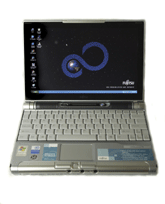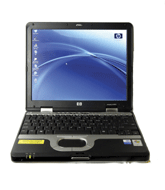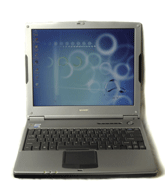Not many users can bring themselves to lug along a nine-pound notebook PC on a trip.[IMGCAP(2)] Most travelers want only basic e-mail, word processing and perhaps a presentation program. They don't watch movies, play games or process photos. Or they're so overloaded with other luggage that a full-size notebook is not an option.The ultraportable notebook was designed for just such travelers. In the past, they had to be content with a single spindle, or drive, and to carry a brick or docking station if they really needed an optical drive or extra ports.Everyone tried to get all the heavy work done while docked at the office. But sometimes in the turmoil of travel, a necessary drive would be left behind when the notebook was undocked.A few ultraportable vendors have begun branching off from this time-tested though frustrating format.[IMGCAP(3)]The Panasonic ToughBook CF-W2 was one of the most revolutionary notebook designs we've seen in a long time. It had an internal optical and 37.2G hard drive but weighed less than three pounds. How did they make a dual-spindle design so light? No other vendor in this review could accomplish the feat without an external docking station. Panasonic's secret might be the placement of the optical drive. The DVD- and CD-rewritable combo sat to the left of the touchpad and below the keyboard, in a spot that's usually wasted space. When we slid the lever, the drive area popped open and up like a trapdoor. The touchpad itself was part of the door that popped up when the drive was opened.A 900-MHz Intel Centrino chip helped the CF-W2 score 3,437 on the GCN Lab's benchmark suite from Alterion Corp. of Conshohocken, Pa., which takes as its baseline a 1.1-GHz Intel Celeron desktop PC with 256M of RAM.[IMGCAP(4)]The desktop's baseline score of 3,365 combines various system functions including graphics performance and raw number crunching. The CF-W2 wasn't the fastest system in this review, but it had plenty of speed for most applications. Its $2,150 price fell in the midrange for a notebook with 12.1-inch screen. We gave it an A+ and a Reviewer's Choice designation as the epitome in ultraportability.The Dell Latitude D400, the fastest notebook in the review, just barely beat the Gateway 200ARC, scoring 5,308. The D400 was a traditional ultraportable weighing 3 pounds, 15 ounces without power cables and optical drive. Adding those components raised the weight to 5 pounds, 14 ounces, which put it close to the six-pound, triple-spindle desktop replacement class.While traveling with just the notebook, we enjoyed a fairly long run: two hours, 21 minutes playing a movie we copied to the big, 37.2G hard drive.The $2,051 price tag included 512M of RAM that, coupled with a 1.7-GHz Pentium M processor, accounted for the high benchmark scores. The D400's Broadcom Corp. wireless chip worked extremely well in our tests.[IMGCAP(5)] We gave the D400 an A- and a Reviewer's Choice designation for blazing speed in a conventional ultraportable format.The IBM ThinkPad R40 was a great all-around performer. It did not completely outclass its competitors on any one test, but it scored well on everything and had few weak points.The 1.3-GHz Intel Centrino chip with 256M of RAM produced a 4,242 benchmark score, at the upper end of speedy performers in this review. The ThinkPad ran on battery for 3 hours, 17 minutes'again, a great score but not the best.The main problem was the 15.7G hard drive, the smallest in the review. The unit's 3-pound, 10-ounce weight almost doubled to 6 pounds, 4 ounces with the optical drive attached, so users would have to install as many applications as possible on the hard drive to avoid carrying all that extra weight'and the hard drive wasn't capacious.The ATI Mobility Radeon chip was far superior to the standard Intel integrated graphics in most of the other notebooks.We gave the R40 an A' and the third Reviewer's Choice designation in this review for being a good performer and above average in almost every way.The Fujitsu LifeBook P5000 cost the least of any notebook in the review and, like the Toughbook CF-W2, had a small format.[IMGCAP(6)]The LifeBook measured only 10.6 by 7 inches by 1.5 inches, little more than half the size of a standard notebook. With its optical drive, it weighed only 3 pounds, 14 ounces.But the P5000 sacrificed screen size for weight. The screen measured only 10.6 inches diagonally, and it was rectangular instead of square. Even so, it displayed movies or pictures quite well, but there wasn't enough screen area for editing Word documents or Adobe Photoshop images.At $1,499, it would be a great buy as a very portable notebook. The LifeBook P5000 earned a B+ and the lab's Bang for the Buck designation for doing its job for the least cash.The Dell Latitude X300, one of two Dells submitted for this review, was extremely light when detached from its docking station, at 3 pounds, 6 ounces. It was also reasonably priced at $1,925, and its 1.2-GHz Pentium M processor performed well on the benchmark, scoring 4,481.The Achilles' heel was a battery that lasted less than two hours in our tests, which put it at the low end in this review. But the weight and price were good enough to earn it a B+.Weighing 3 pounds, 11 ounces, the Hewlett-Packard nc4000 was one of the lightest notebooks in the review if we didn't count all the parts. Unfortunately, the addition of the battery charger and optical drive made the nc4000 the heaviest of all at 6 pounds, 2 ounces. A desktop replacement might be a better choice, as the total weights are similar.[IMGCAP(7)]Users could leave the optical drive behind but should definitely pack the power cable. Despite a powerful 4,195 Alterion benchmark score, the nc4000's lithium-ion battery couldn't store much of a charge. On our battery-drain benchmark, the HP was the third-worst performer. It shut down after 2 hours, 12 minutes.On the plus side, the 1.6-GHz Pentium M chip and 350M ATI Radeon 9100 IGP graphics card outperformed the embedded Intel card found on most of the other contenders.At $2,299, the Sony Vaio PCG-TR1A cost slightly more than the $2,051 HP nc4000 but had a few extras. Both notebooks received a B grade.The sub-4-pound, dual-spindle Vaio had a big 508M of RAM plus an 893-MHz Pentium Centrino processor. That was more RAM than the HP had, but the slower processor resulted in a lower, 3,570 benchmark score for the Vaio.Despite the weak score, the Vaio stood out on the battery test, running for an impressive three hours, 27 minutes. At 3 pounds, 2.6 ounces, it weighed 8 ounces less than the HP. A built-in CD-RW/DVD-ROM combo drive shaved 1.5 inches off the 1,280- by 768-pixel TFT screen. That 1.5-inch loss showed up particularly in editing PowerPoint presentations or manipulating media.[IMGCAP(8)] Panasonic first sent us the wrong machine when it submitted the CF-18 Toughbook Tablet PC as an ultraportable notebook. After we notified Panasonic, it sent the more appropriate CF-W2, our top scorer in this review.But after running the benchmarks on the CF-18, we decided it's not only a viable alternative to ultraportables but also a strong competitor in their market.The 900-MHz Centrino had the best battery performance in the review: four hours, 48 minutes'75 minutes longer than its closest competitor, the Toughbook CF-W2.Portable though slightly heavy at 4 pounds, 9.4 ounces, the CF-18 had a large, 37.2G hard drive and a 10.4-inch screen, which seemed larger than the Sony's or Fujitsu's 10.6-inch LCD mainly because of its box-shaped frame.With a 4,323 score on the Alterion benchmark, the CF-18 came in fourth overall. It was fully ruggedized and had some extra features such as a touch screen and removable hard drive.The longest-lasting battery in the review, however, came at a high price. The $3,200 CF-18 was the costliest system of all, and that did not include an optical drive, which would have to be bought separately.[IMGCAP(9)]Those two negatives brought down the CF-18's overall grade to B' despite some advanced features. As a Tablet PC it scored well enough, however, to be a credible alternative to notebooks, especially for light weight in hostile environments.Despite the second-highest Alterion benchmark score, 5,302, the Gateway 200ARC didn't fare well on the other tests.It had the second-worst battery performance, dying in one hour, 39 minutes. Because the Gateway notebook was also the largest in the review at 12.4 by 10.2 by 9.4 inches, it had enough room for a better battery.Although the size made possible the largest LCD screen in the review, 14.1 inches, the 5-pound, 2.6-ounce weight hardly seemed worth it.The Gateway's 1.6-GHz Centrino chip in combination with 504M of RAM and 55.8G hard drive made the 200ARC powerful, but its bulk, poor battery performance and high $2,339 price tag brought it down.The Centrino, a Pentium M chip with embedded Intel 802.11b wireless connectivity, was part of six notebooks in this review. The other Pentium Ms except for one had third-party wireless connectivity. See the table for wireless chip details.The Sharp Actius PC-MV14 had a 1.2-GHz mobile Pentium III processor, 256M of RAM and a large, 37.2G hard drive. But the Pentium III didn't do so well against the Pentium M units in the review. It received the lowest benchmark score: 3,161.[IMGCAP(10)]Although the Sharp didn't perform well on the Alterion benchmark, we were impressed that a mobile Pentium III and such a large drive could fit into an 11.1- by 9.4- by 1-inch frame weighing 4 pounds, 3 ounces. On the battery drain test, the Sharp lasted 2 hours, 26 minutes'five minutes longer than the Dell D400. Sharp's well-designed power supply was among the smallest and easiest to carry, and it added only 12.6 ounces to the total weight'just shy of 5 pounds.Although the Actius PC-MV14 wasn't overpriced at $1,999, its low benchmark score and relatively sluggish performance earned a C grade.Toshiba America Information Systems Inc. surprised us. It had outscored the competition by a significant margin in our last notebook comparison. But in spite of the Porteg' R100's 897-MHz Pentium Centrino chip and 256M of RAM, it had the second-lowest Alterion benchmark score: 3,356.It also scored the lowest on the battery test, lasting only one hour, 17 minutes before shutting down. Those two factors, along with no optical drive and a high $2,299 price tag, gave the R100 the bottom grade. Its advantage was very small size plus the lowest weight in the review.
Panasonic Toughbook CF-W2
Panasonic Toughbook CF-18
















